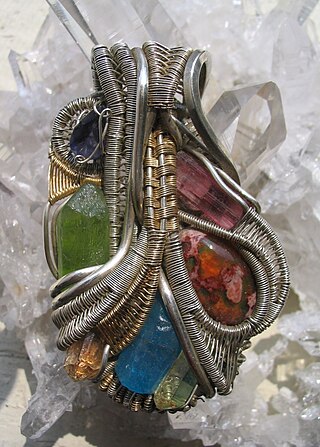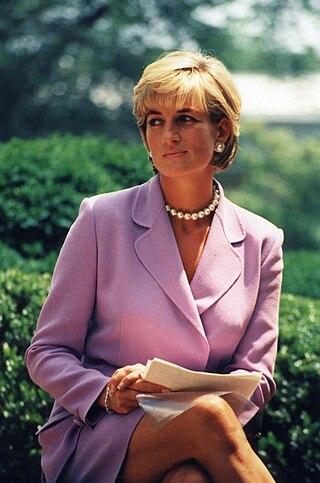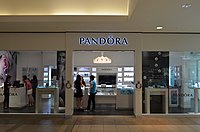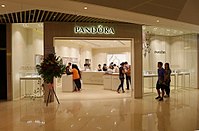
Costume or fashion jewelry includes a range of decorative items worn for personal adornment that are manufactured as less expensive ornamentation to complement a particular fashionable outfit or garment as opposed to "real" (fine) jewelry, which is more costly and which may be regarded primarily as collectibles, keepsakes, or investments. From the outset, costume jewelry — also known as fashion jewelry — paralleled the styles of its more precious fine counterparts.

Jewellery consists of decorative items worn for personal adornment, such as brooches, rings, necklaces, earrings, pendants, bracelets, and cufflinks. Jewellery may be attached to the body or the clothes. From a western perspective, the term is restricted to durable ornaments, excluding flowers for example. For many centuries metal such as gold often combined with gemstones, has been the normal material for jewellery, but other materials such as glass, shells and other plant materials may be used.

A necklace is an article of jewellery that is worn around the neck. Necklaces may have been one of the earliest types of adornment worn by humans. They often serve ceremonial, religious, magical, or funerary purposes and are also used as symbols of wealth and status, given that they are commonly made of precious metals and stones.

A bracelet is an article of jewellery that is worn around the wrist. Bracelets may serve different uses, such as being worn as an ornament. When worn as ornaments, bracelets may have a supportive function to hold other items of decoration, such as charms. Medical and identity information are marked on some bracelets, such as allergy bracelets, hospital patient-identification tags, and bracelet tags for newborn babies. Bracelets may be worn to signify a certain phenomenon, such as breast cancer awareness, or for religious/cultural purposes.

Cufflinks are items of jewelry that are used to secure the cuffs of dress shirts. Cufflinks can be manufactured from a variety of different materials, such as glass, stone, leather, metal, precious metal or combinations of these. Securing of the cufflinks is usually achieved via toggles or reverses based on the design of the front section, which can be folded into position. There are also variants with chains or a rigid, bent rear section. The front sections of the cufflinks can be decorated with gemstones, inlays, inset material or enamel and designed in two or three-dimensional forms.

Jewellery findings are the parts used to join jewellery components together to form a completed article.
Jewelry of the Etruscan civilization existed in several eras.

Wire wrapping is one of the oldest techniques for making handmade jewelry. This technique is done with jewelry wire and findings similar to wire to make components. Wire components are then connected to one another using mechanical techniques with no soldering or heating of the wire. Frequently, in this approach, a wire is bent into a loop or other decorative shape and then the wire is wrapped around itself to finish the wire component. This makes the loop or decorative shape permanent. The technique of wrapping wire around itself gives this craft its name of wire wrapping.

Colored gold is the name given to any gold that has been treated using techniques to change its natural color. Pure gold is slightly reddish yellow in color, but colored gold can come in a variety of different colors by alloying it with different elements.
Cathy Waterman is a California based jewelry designer and a member of the Council of Fashion Designers of America. She designs “ethereal, feminine, lyrical” jewelry using recycled metals and fair trade stones.
James Avery Artisan Jewelry is a Texas-based, family-owned company that specializes in designing hand-crafted rings, bracelets, necklaces, charms, earrings, and other jewelry. Its founder, James Avery, first started crafting jewelry in Kerrville, Texas in 1954 out of his (then) mother-in-law's garage. Over time, the company expanded and became well-known for its distinctive designs and attention to detail. The business has grown to more than 120 of its own stores across Texas, Georgia, Louisiana and Oklahoma. The company has studios, workshops and manufacturing facilities in Kerrville, Fredericksburg, Cedar Park, Comfort, Hondo and Corpus Christi. There are more than 3,000 regular James Avery employees across all its locations.

Native American jewelry refers to items of personal adornment, whether for personal use, sale or as art; examples of which include necklaces, earrings, bracelets, rings and pins, as well as ketohs, wampum, and labrets, made by one of the Indigenous peoples of the United States. Native American jewelry normally reflects the cultural diversity and history of its makers, but tribal groups have often borrowed and copied designs and methods from other, neighboring tribes or nations with which they had trade, and this practice continues today. Native American tribes continue to develop distinct aesthetics rooted in their personal artistic visions and cultural traditions. Artists may create jewelry for adornment, ceremonies, and display, or for sale or trade. Lois Sherr Dubin writes, "[i]n the absence of written languages, adornment became an important element of Indian communication, conveying many levels of information." Later, jewelry and personal adornment "...signaled resistance to assimilation. It remains a major statement of tribal and individual identity."

Ancient Egyptian clothes refers to clothing worn in ancient Egypt from the end of the Neolithic period to the collapse of the Ptolemaic Kingdom with the death of Cleopatra in 30 BC. Egyptian clothing was filled with a variety of colors. Adorned with precious gems and jewels, the fashions of the ancient Egyptians were made for not only beauty but also comfort. Egyptian fashion was created to keep cool while in the hot desert.

Traditional metal working in Mexico dates from the Mesoamerican period with metals such as gold, silver and copper. Other metals were mined and worked starting in the colonial period. The working of gold and silver, especially for jewelry, initially declined after the Spanish conquest of the Aztec Empire. However, during the colonial period, the working of metals rose again and took on much of the character traditional goods still have. Today, important metal products include those from silver, gold, copper, iron, tin and more made into jewelry, household objects, furniture, pots, decorative objects, toys and more. Important metal working centers include Taxco for silver, Santa Clara del Cobre for copper, Celaya for tin and Zacatecas for wrought iron.
DYRBERG/KERN is a Danish jewelry company founded by Gitte Dyrberg and Henning Kern in 1985.
Francesca Amfitheatrof is a jewelry designer and Artistic Director Watches and Jewellery of Louis Vuitton. Before that, she was the design director at Tiffany & Co.

Ancient Roman jewelry was characterized by an interest in colored gemstones and glass, in contrast with their Greek predecessors who focused primarily on the production of high-quality metalwork by practiced artisans. Extensive control of Mediterranean territories provided an abundance of natural resources to utilize in jewelry making. Participation in trade allowed access to both semi-precious and precious stones that traveled down the Persian Silk Road from the East.

Diana, Princess of Wales, owned a collection of jewels both as a member of the British royal family and as a private individual. These were separate from the coronation and state regalia of the crown jewels. Most of her jewels were either presents from foreign royalty, on loan from Queen Elizabeth II, wedding presents, purchased by Diana herself, or heirlooms belonging to the Spencer family.
Khmer jewellery originated in the Khmer Empire. Khmer jewellery has been produced since the 6th or 7th century. Jayavarman VII, while he was an influential figure who established the different trends in Khmer jewellery, is famously represented without any at all in the seated position. The amount of jewellery acquired in Cambodia traditionally established a person's identity and status. Khmer jewellery consists of a diverse variety of styles and fashions. These styles can be categorised into three distinct groups: royal jewellery, wedding jewellery and the jewellery for the Cambodian Royal Ballet.
Catbird is an American jeweler. It was founded in 2004 in Brooklyn, New York. It has influenced several trends in jewelry fashion. The brand is particularly popular among Millenials.


















